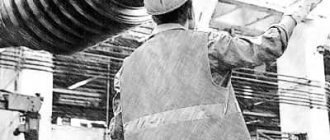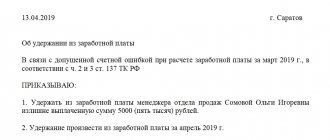Author of the article: Vladimir Danilevsky Last modified: January 2021 18472
Withholding for workwear upon dismissal is a legal practice of enterprises. The products are designed to protect workers from exposure to negative factors in the workplace. The completeness and properties of protective equipment may vary significantly depending on the field of human activity. At the same time, the current legislation clearly establishes the procedure for issuing items to subordinates and the process of returning them to the organization upon dismissal. The last procedure will be discussed in detail in the article.
How is workwear taken into account when an employee is dismissed in accounting - postings
Important! If a set of workwear per employee costs more than 40 thousand rubles, the clothing should be taken into account simultaneously with the company’s fixed assets. The cost of such expensive items is written off in equal installments over 12 months (this is the optimal period of use).
Working clothes are purchased by an enterprise for the purpose of issuing them to employees who are required to wear them due to the specific nature of their activities. The delivery of the kit is carried out on the basis of the demand invoice. At the same time, the accountant must make the appropriate entries.
If the accountant is going to write off the cost of workwear partially (in equal shares for the full period of use of the workwear by the employee), the following entries are made:
| Wiring | DEBIT | CREDIT |
| The uniform was issued to the employee | 10-11 | 10-10 |
| The cost of workwear is written off every month in equal shares, distributed over the entire period of operation | 20, 23, 25 | 10-11 |
| The remainder of the cost of workwear is written off as other costs if it is damaged, lost, or returned upon dismissal of an employee. | 91-1 | 10-11 |
If it was decided to write off the cost of workwear at a time, other entries are made:
| Wiring | DEBIT | CREDIT |
| Special clothing issued to the employee | 10-11 | 10-10 |
| The total cost of workwear was written off as expenses. | 20, 23, 25 | 10-11 |
Return procedure
As noted earlier, the return of special clothing upon dismissal of a subordinate is a mandatory condition. It is for this reason that it is often indicated as a separate item on the bypass sheet. When a citizen decides to leave his position, he must decide what exactly to do with the protective clothing issued earlier.
There are generally established rules according to which an employee can:
- pass it in full;
- give partly and reimburse the rest to the company or enterprise;
- pay the remaining cost in full.
Many businesses and other organizations provide a choice to the person leaving their job. Often the service life of the issued special form is running out, which is why it can no longer be used. In this case, automatic write-off is carried out.
It should be noted that the write-off of special clothing when a particular citizen leaves work is carried out with the obligatory execution of accounting documents. This must be reflected in the relevant accounting accounts.
According to generally established rules, a company or enterprise has the right to withhold from a resigning person only those amounts that correspond to reality. In this case, we are talking about the fact that only the real cost of the uniform can be written off from the employee.
To further calculate future deductions, it is recommended to determine on what basis the deduction will be made. If the return of workwear upon dismissal of an employee is impossible due to practical wear and tear, then this is an objective reason.
But when the quitter was caught selling workwear on the side or there was deliberate damage to the uniform, then this is a completely different story. If a former subordinate is found to have committed actions intentionally, he may be debited with amounts that are equivalent to the market value of damaged or sold items.
Workwear upon dismissal of an employee: how to return workwear to an employee
During the entire period of operation of the workwear, it is registered with the employee who uses it. If the service life of the kit has expired, or under the influence of external factors the uniform items have become unusable, the workwear has to be written off from the balance sheet. However, if an employee is to blame for damage or loss of clothing, he is obliged to compensate the company for losses by paying the cost of the set to the cashier in cash. It is also possible to withhold an amount from wages if the payment is made in cashless form. In this case, the accountant is required to make the appropriate entries. When writing off clothes in shares:
| DEBIT | CREDIT | Wiring |
| 10-10 | 10-11 | An employee returned a set of clothes to the company |
| 94 | 10-11 | The cost of clothing is recognized as a loss if the employee does not return it. |
| 73 “Settlements with personnel for other operations” | 94 | Loss caused by an employee who did not return clothes |
| 50, 51 | 73 | The employee transferred money for loss or damage to clothing |
| 70 | 73 | Losses were withheld from the employee's salary |
If it is customary for an enterprise to write off the cost of workwear at once, as a total amount, the following entries are made:
| DEBIT | CREDIT | Wiring |
| 73 | 91-1 “Other income and expenses” (sub-account “Other income”) | The cost of personal protective equipment is written off as an expense as a loss. |
| 50 "Cashier" | 73 | The employee returned the money for the clothes to the cash register in cash. |
| 70 “Settlements with personnel for wages” | 73 | The cost of clothing was deducted from the employee's salary |
Arbitrage practice
The Oktyabrsky City Court of the Republic of Bashkortostan accepted for consideration the claim from Oil-Service LLC. A representative of the organization applied to the court with a request to recover from the resigned employee the amount for unreturned personal protective equipment. On the merits of the case the following was reported:
- The organization employed an employee who acted as a lift operator.
- Due to the specifics of the profession, the employee was provided with special clothing in the form of an insulated men's suit and special footwear in the form of winter boots.
- The employee wrote a letter of resignation of his own free will and the contract with him was terminated within the legal time frame.
- However, upon settlement, he did not return the PPE issued to him.
The employer tried to resolve the issue peacefully and sent written requests to the dismissed person asking for the return of PPE or money, but no answers were received.
The defendant did not appear at the court hearing, so a default judgment was made.
Since the applicant argued the residual value of the issued protective clothing and confirmed it with documents, the judge fully satisfied the claims and ordered to recover from the defendant not only the damage caused, but also the amount of the state duty paid for the filed claim. Decision of September 12, 2021 in case No. 2-1763/2017
Working clothes when dismissing an employee: what taxes will the employee pay?
Since the workwear does not belong to the employee, but is the property of the organization that issued it, the employee must treat the uniform with care and return the set back to the company. For example, if:
- the subordinate decided to leave the company;
- the employee has moved to a new position or workplace;
- the overalls have become unsuitable for further wear (due to natural wear and tear or damage).
| The employee returned the workwear | The employee left the workwear with him or lost it |
| The workwear is transferred back to the company; the remaining cost after normal wear and tear of the uniform is reimbursed from the employee’s funds; the number of items transferred is debited from the employee’s personal card; Personal income tax is not paid. | The employee received an intangible benefit - income, keeping his clothes; the cost of workwear is subject to personal income tax, which is withheld from the employee; the tax is paid to the Federal Tax Service; the amount of income is taken into account in the certificate in form 2-NDFL when registering dismissal. |
Refund of Residual Cost of Clothes
This also includes salmon, beluga caviar, crab meat, lobsters. Exemption from taxation The food products themselves will be subject to mandatory VAT upon sale at a rate of either 10% or 18%. However, transactions with food products may be exempt from tax. According to the Tax Code of the Russian Federation, such types of activities include the sale of food products by public catering organizations, the sale of food products in educational and medical institutions. There is no taxation of organizations exempt from VAT due to low turnover and small revenue based on previous activities. Entities using preferential regimes, such as UTII, Unified Agricultural Tax, Simplified Tax System, PSN, are also not required to impose VAT on food products. These conditions affect production and further sale, including resale of goods.
- find out the cadastral number of the plot using the public cadastral map of Rosreestr (for this you need to know the address of the property);
- at the regional office of the Registration Chamber, obtain details for paying the state fee;
- pay the state fee;
- draw up and send a request to the district office of the Unified State Register indicating the address (detailed description of the location) of the object, its cadastral number and your full name.
Expert opinion on the question of in what cases it is necessary to issue protective clothing
Experts from the Ministry of Health provide the following list of cases in which it is necessary to provide workers with special clothing to protect them from pollution, high temperature and other damage:
- chemical and laboratory work related to chemicals, caustic solutions and substances;
- Car/truck repairs;
- production of units, power tools, assembly of special equipment;
- works related to paints and varnishes, mechanical engineering;
- non-ferrous metallurgy, iron foundry metallurgy, steel works;
- metalworking, milling, metalworking.
What applies to workwear
The composition must be determined taking into account the standards provided for by Order of the Ministry of Finance of the Russian Federation No. 135n of 2002. It stipulates that workwear includes:
- body protective equipment made in the form of clothing (overalls, gowns, suits, jackets, mittens, etc.);
- foot protection (special footwear of various modifications);
- protective equipment (PPE) - respirators, goggles, etc.
The specific composition of the overalls depends on what specific functions are assigned to the worker and from what hazardous factors it should protect him.
Common mistakes
Error: The accountant wrote off damaged workwear without deducting its cost from the employee’s salary.
Comment: If the workwear is worn out naturally, its cost is not deducted from the employee’s salary. If an employee damages or loses clothing, its cost must be compensated at the expense of the subordinate.
Error: The accountant did not withhold personal income tax from the cost of workwear, which the dismissed employee did not return to the company.
Comment: The workwear left behind is the employee’s income, and therefore personal income tax is withheld from its value, plus its value is indicated in the income certificate 2-NDFL.
Special protective equipment
Collective and individual protective equipment helps preserve the life and health of workers. A special category is given to workwear, which provides protection for the very vulnerable human body from the effects of external production factors.
In accordance with Article 209 of the Labor Code of the Russian Federation, special protective equipment makes it possible to protect a person from harmful and dangerous factors that affect them during the performance of work duties, as well as to avoid contamination. Personal protective equipment (PPE) helps prevent consequences that cannot be eliminated with collective protective equipment. In addition, they can be selected individually, which increases the level of security.
Personal protective equipment is produced in accordance with the rules of the technical regulations of the Customs Union “On the safety of personal protective equipment” TR CU 019/2011.
Refund of residual value of special clothing
1C free 1C-Reporting 1C:ERP Enterprise management 1C:Free 1C:Accounting 8 1C:Accounting 8 CORP 1C:Accounting of an autonomous institution 1C:Accounting of a state institution 1C:Municipal budget 1C:Settlement budget 1C:Clothing allowance 1C:Money 1 C: Document flow 1C: Salaries and personnel of a budgetary institution 1C: Salaries and personnel of a government institution 1C: Salaries and personnel management 1C: Salaries and personnel management CORP 1C: Integrated automation 8 1C: Lecture hall 1C: Enterprise 1C: Enterprise 7.7 1C: Enterprise 8 1C: Retail 1C: Management of our company 1C: Management of a manufacturing enterprise 1C: Trade management 1 Enterprise 8
We use cookies to analyze traffic, tailor content and advertising to you and enable you to share on social media. If you continue to use the site we will assume that you are happy with it.







